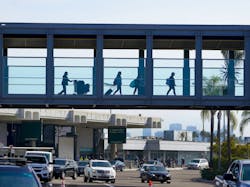Pandemic Slashed San Diego Airport Revenue, but $3B Terminal 1 Project is Still a Go
A little more than a year after the rapid spread of the coronavirus brought air travel to a near halt, the governing board of the San Diego airport on Thursday approved a $296 million operating budget and a five-year, $3.6 billion capital project spending plan that will help the facility navigate the pandemic recovery while also preserving its costly plan to overhaul Terminal 1.
Thanks to significant cuts in expenses — including an ongoing hiring freeze — and what's expected to be nearly $200 million in federal relief, the San Diego Regional Airport Authority said it was able to produce a still healthy budget for the coming 2021-22 fiscal year.
While the budget's financial underpinnings assume a slow but steady recovery as people feel more comfortable flying, San Diego airport officials are still hopeful that actual revenues will ultimately exceed its conservative forecast.
For this fiscal year, which ends June 30, it is expected that just 4.5 million people will have boarded planes departing from San Diego compared to 2019's nearly 12.4 million passengers — an indication of the enormity of the pandemic's impact on travel. Airport officials are projecting 6.3 million passengers for the coming fiscal year, increasing to 8.8 million in the 2022-23 fiscal year.
"Who knows what's going to happen, right?" Airport Authority Chief Financial Officer Scott Brickner said in an interview. "There could be (COVID-19) mutations and God help us if that happens. But we are being a little conservative. International travel is still very unknown and business travel as well. Anecdotally, we're hearing business travel will pick up slowly but we don't think it will come back real strong quite yet."
Just last month, though, passenger numbers have started ticking up, giving airport officials hope that the recovery will come more quickly than they're currently projecting. On May 23, for example, 28,698 people passed through the TSA checkpoints, which was down 8 percent compared to the same time in 2019. The airport, however, ended the month of May down 41 percent overall in passenger boardings compared to May 2019.
"There's no question that the COVID-19 pandemic has posed an unprecedented challenge for the Airport Authority and the entire San Diego region," CEO Kimberly Becker said following the budget hearing. "When the pandemic first hit, we implemented our Financial Resilience Plan, which included a hiring freeze, a hold on more than $200 million in capital projects, and numerous cost reductions across the entire Authority ... Years of prudent financial management and recent federal aid have enabled the Airport Authority to build adequate reserves to help offset non-airline revenue losses as well as provide critically needed financial relief to our airline and non-airline partners."
In the meantime, the airport is moving forward with plans to eventually replace its aging, 1960s-era Terminal 1 building, which will eventually have 11 more gates than the existing 19. The Airport Authority board next month will be presented with a more specific plan for advancing what is its single biggest project. So far, just $125 million in spending has been authorized, Brickner said.
Most of the project cost will be debt-financed, with repayment of bonds expected to begin in 2025, Becker said. The airport hopes to start construction early next year.
"Our airline partners, through a separate agreement announced in 2019, have committed to pay a large portion of the annual debt service," she noted. "Throughout the pandemic, that agreement has remained in place, and all parties are eager to see the new T1 improvements become reality as soon as possible."
The airport's overall operating expense budget of $295.9 million, as it's called, represents a 2.6 percent increase over the current year budget, due in part to Terminal 1-related costs and the facility's "quieter home program."
It doesn't differ much in magnitude from the Airport Authority's 2019 pre-pandemic budget of $298.6 million, but on the revenue side, there is a bigger difference. The 2022 fiscal year "revenue budget" of $397.3 million is down from the $412.5 million in revenue for fiscal year 2019.
Among the planned capital projects that the airport has deferred in the interest of saving money are the modernization of the Terminal 2 East's baggage handling system ($15.9 million), additional shuttle buses for the Rental Car Center ($10 million), and pavement rehabilitation in front of Terminal 2 ($2 million).
The most noticeable impact on the San Diego International Airport's finances is in the area of non-airline income, which includes concession sales, parking and rental car fees, and what's known as passenger facility charges. Between fiscal years 2020 and 2023, those losses are expected to total $376 million. A combination of federal relief funds and expense reductions totaling $162 million, however, are anticipated to soften the blow.
While far fewer passengers account for the drop in revenue, the Airport Authority has provided some financial relief to its partners like the concessionaires who were hit hard by the travel downturn. The airlines as well received assistance in the form of deferred payment of fees, Brickner said.
This story originally appeared in San Diego Union-Tribune.
___
(c)2021 The San Diego Union-Tribune
Visit The San Diego Union-Tribune at www.sandiegouniontribune.com
Distributed by Tribune Content Agency, LLC.
